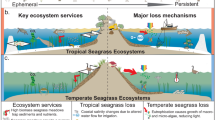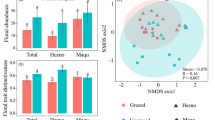Abstract
Black mangrove (Avicennia germinans) reproduces by producing propagules through the process of cryptovivipary, which requires a significant energy investment. We conducted a series of field and greenhouse studies to track propagule production in years of high and low disturbances (i.e., hurricanes), the effects of time and salinity on propagule dispersal potential, and the relationship between hydrology and propagule establishment elevations. Trees tended to produce greater numbers of propagules in years after hurricanes, and individual trees alternated the amount of energy they invested in reproduction in consecutive years. In the greenhouse, propagule buoyancy was affected by salinity with propagules in 36 remaining buoyant for over 110 days and establishment success decreasing with dispersal period length. Finally, a field survey across five sites in southeastern Louisiana revealed that the 2009 cohort of propagules established at significantly lower elevations than mature trees occurred. These findings elucidate some salient features of black mangrove reproductive biology in the northern portion of its North American distribution.







Similar content being viewed by others
References
Allen, J.A., K.W. Krauss, and R.D. Hauff. 2003. Factors limiting the intertidal distribution of the mangrove species Xylocarpus granatum. Oecologia 135: 110–121.
Anten, N.P.R., M. Martinez-Ramos, and D.D. Ackerly. 2003. Defoliation and growth in an understory palm: quantifying the contributions of compensatory responses. Ecology 84(11): 2905–2918.
Ball, M.C. 1988. Ecophysiology of mangroves. Trees 2: 129–142.
Boyd, R., and S. Penland. 1988. Geomorphologic model for Mississippi-Delta evaluation AAPG Bulletin. American Association of Petroleum Geologists 72(9): 1110.
Clarke, P.J. 1993. Dispersal of gray mangrove (Avicennia marina) propagules in southeastern Australia. Aquatic Botany 45(2–3): 195–204.
Clarke, P.J., and W.G. Allaway. 1993. The regeneration niche of the gray mangrove (Avicennia marina)—effects of salinity, light, and sediment factors on establishment, growth, and survival in the field. Oecologia 93(4): 548–556.
Clarke, P.J., R.A. Kerrigan, and C.J. Westphal. 2001. Dispersal potential and early growth in 14 tropical mangroves: do early life history traits correlate with patterns of adult distribution? Journal of Ecology 89(4): 648–659.
Delgado, P., P.F. Hensel, J.A. Jimenez, and J.W. Day. 2001. The importance of propagule establishment and physical factors in mangrove distributional patterns in a Costa Rican estuary. Aquatic Botany 71: 157–178.
Ellison, A.M., and E.J. Farnsworth. 1993. Seedling survivorship, growth, and response to disturbance in Belizean mangal. American Journal of Botany 80(10): 1137–1145.
Farnsworth, E.J. 2000. The ecology and physiology of viviparous and recalcitrant seeds. Annual Review of Ecology, Evolution, and Systematics 31: 107–138.
Grime, J.P. 1977. Evidence for the existence of three primary strategies in plants and its relevance to ecological and evolutionary theory. The American Naturalist 111(982): 1169–1194.
Hester, M.W., and I.A. Mendelssohn. 1989. Water relations and growth responses of Uniola paniculata (sea oats) to soil moisture and water-table depth. Oecologia 78: 289–296.
Hester, M.W., and I.A. Mendelssohn. 1991. Expansion patterns and soil physicochemical characterization of three Louisiana populations of Uniola paniculata (Sea oats). Journal of Coastal Research 7(2): 387–401.
Hester, M.W., E.A. Spalding, and C.D. Franze. 2005. Biological resources of the Louisiana coast: part 1. An overview of coastal plant communities of the Louisiana gulf shoreline. Journal of Coastal Research 44: 134–145.
Kitaya, Y., V. Jintana, S. Piriyayotha, D. Jaijing, K. Yabunki, S. Izutani, A. Nishimiya, and M. Iwasaki. 2002. Early growth of seven mangrove species planted at different elevations in a Thai estuary. Trees 16: 150–154.
Krauss, K.W., T.W. Doyle, R.R. Twilley, V.H. Rivera-Monroy, and J.K. Sullivan. 2006. Evaluating the relative contributions of hydroperiod and soil salinity on growth of south Florida mangroves. Hydrobiologia 569: 311–324.
Krauss, K.W., C.E. Lovelock, K.L. McKee, L. Lopez-Hoffman, S.M.L. Ewe, and W.P. Sousa. 2008. Environmental drivers in mangrove establishment and early development: a review. Aquatic Botany 89: 105–127.
Lewin, R. 1986. Supply-side ecology. Science 234: 25–27.
Lewis III, R.R. 2005. Ecological engineering for successful management and restoration of mangrove forests. Ecological Engineering 24: 403–418.
Lewis, R.R. III and E.D. Estevez. 1988. The ecology of Tampa Bay, Florida: An estuarine profile. National Wetlands Research Center, US Fish and Wildlife Service. Biological Report No 85. 132 pp.
Lopez-Hoffman, L., D.D. Ackerly, N.P.R. Anten, J.L. Denoyer, and M. Martinez-Ramos. 2007. Gap-dependence in mangrove life-history strategies: a consideration of the entire life cycle and patch dynamics. Journal of Ecology 95: 1222–1233.
McBride, R.A., and M.R. Byrnes. 1997. Regional variations in shore response along barrier island systems of the Mississippi River delta plain: historical change and future prediction. Journal of Coastal Research 13(3): 628–655.
McKee, K.L. 1995. Seedling recruitment patterns in a Belizean mangrove forest: effects of establishment ability and physico-chemical factors. Oecologia 101: 448–460.
McMillan, C. 1971. Environmental factors affecting seedling establishment of the black mangrove on the central Texas coast. Ecology 52(5): 927–930.
Nettel, A., and R.S. Dodd. 2007. Drifting propagules and receding swamps: genetic footprints of mangrove recolonization and dispersal along tropical coasts. Evolution 61(4): 958–971.
Patterson, C.S., K.L. McKee, and I.A. Mendelssohn. 1997. Effects of tidal inundation and predation on Avicennia germinans seedling establishment and survival in a sub-tropical mangal/salt marsh community. Mangroves and Salt Marshes 1: 103–111.
Pickens, C.N., and M.W. Hester. 2010. Temperature tolerance of early life history stages of black mangrove Avicennia germinans: implications for range expansion. Estuaries and Coasts. doi:10.1007/sl12237-010-9358-2.
Proffit, C.E., E.C. Milbrandt, and S.E. Travis. 2006. Red mangrove (Rhizophora mangle) reproduction and seedling colonization after Hurricane Charley: comparisons of Charlotte Harbor and Tampa Bay. Estuaries and Coasts 29(6): 972–978.
Rabinowitz, D. 1978. Dispersal properties of mangrove propagules. Biotropica 10(1): 47–57.
Reekie, E.G., and F.A. Bazzaz. 1987a. Reproductive effort in plants. 1. Carbon allocation to reproduction. The American Naturalist 129(6): 876–896.
Reekie, E.G., and F.A. Bazzaz. 1987b. Reproductive effort in plants. 2. Does carbon reflect the allocation of other resources? The American Naturalist 129(6): 897–906.
Saenger, P. 2002. Mangrove ecology, silviculture, and conservation. Dordrecht: Kluwer.
Sampson, M.S., and R.N. Rollon. 2008. Growth performance of planted mangroves in the Philippines: revisiting forest management strategies. Royal Swedish Academy of Science 37(4): 234–240.
Smith III, T.J. 1987. Effects of light and intertidal position on seedling survival and growth in tropical tidal forests. Journal of Experimental Marine Biology and Ecology 110: 133–146.
Sousa, W.P., P.G. Kennedy, B.J. Mitchell, and B.M. Ordonez. 2007. Supply-side ecology in mangroves: do propagule dispersal and seedling establishment explain forest structure? Ecological Monographs 77(1): 53–76.
Toledo, G., A. Rojas, and Y. Bashan. 2001. Monitoring of black mangrove restoration with nursery-reared seedlings on an arid coastal lagoon. Hydrobiologia 444: 101–109.
Tomlinson, P.B. 1986. The Botany of Mangroves. Cambridge: Cambridge University Press.
Visser, J.M., W.G. Vermilion, D.E. Evers, R.G. Linscombe, and C.E. Sasser. 2005. Nesting habitat requirements for brown pelican and their management implications. Journal of Coastal Research 21(2): e27–e35.
Ye, Y., N.F.Y. Tam, Y.S. Wong, and C.Y. Lu. 2004. Does sea level rise influence propagule establishment, early growth and physiology of Kandelia candel and Bruguiera gymnorrhiza? Journal of Experimental Marine Biology and Ecology 306: 197–215.
Acknowledgments
We would like to extend our gratitude to support provided by NOAA/CREST (National Oceanic and Atmospheric Administration/Coastal Restoration and Enhancement Through Science and Technology) and CSAP (Coastal Science Assistantship Program) provided by LA OCPR (Louisiana Office of Coastal Protection and Restoration) and Louisiana Sea Grant. We would also like to thank the members of the Coastal Plant Ecology Lab who helped with the collection of data in the field: Christine Pickens, Michael Dupuis, and Jonathan Willis. Additional thanks to Theryn Henkel, Joe Baustian, and Sean Graham for providing data and support for this project.
Author information
Authors and Affiliations
Corresponding author
Rights and permissions
About this article
Cite this article
Alleman, L.K., Hester, M.W. Reproductive Ecology of Black Mangrove (Avicennia germinans) Along the Louisiana Coast: Propagule Production Cycles, Dispersal Limitations, and Establishment Elevations. Estuaries and Coasts 34, 1068–1077 (2011). https://doi.org/10.1007/s12237-011-9404-8
Received:
Revised:
Accepted:
Published:
Issue Date:
DOI: https://doi.org/10.1007/s12237-011-9404-8




